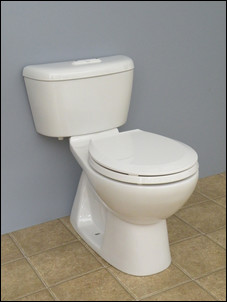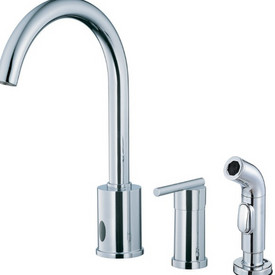If you’re interested in both protecting the Earth’s resources and keeping a few dollars in your wallet, consider auditing your home’s water usage and make any necessary upgrades. By using less water, you prevent wasting a precious and limited resource. You also help reduce the amount of energy needed to treat, transport and then heat that water. But the planet isn’t the only beneficiary when you incorporate water-saving solutions. The average home spends $500 per year on its water and sewer bill, according to the U.S. Environmental Protection Agency. But by updating to high-efficiency toilets and showerheads, you can put as much as $170 back in your bank account. That’s a 34 percent savings.
 The Caroma Sydney Low Profile Toilet uses 1.6/0.8 gallons per flush (full/half flush). |
And the good news is you can save the Earth and save some money without sacrificing performance.
“The technology has come a long way in the last 15 years,” says Shane Judd, senior product manager for water conservation at Kohler Co. in Kohler, Wisc. “We want to provide a product that has quality, that has great design, that works well and that, by the way, saves water.”
To see this idea in action, you need look no further than the toilet section of your local home improvement store.
Water-Saving Toilets
Toilets account for 30 percent of a home’s total water consumption. So, if you make just one change, upgrading this fixture could give you the biggest bang for your buck. Look for a toilet certified by the Environmental Protection Agency’s WaterSense program. These units use 1.28 gallons per flush, which is 20 percent less water than the current federal standard. EPA estimates that a family of four that upgrades its toilet will save more than $90 per year on their water bill and $2,000 over the life of the toilet. Considering that you can purchase a WaterSense toilet for less than $200, that’s a respectable return on your investment. (For more information on the WaterSense program, read “Making Sense of WaterSense.”)
In countries such as Australia where water saving has long been a priority, dual-flush toilets are virtually the only kind available. These toilets use 0.8 gallons for liquid waste and 1.6 gallons for solid waste. The latest toilet from Caroma, an Australian company, called the Sydney Low Profile uses 1.6/0.8 gallons per flush (full/half flush). Caroma now has 41 toilets that are WaterSense-approved—more than any other manufacturer.
And then there is a pressure-assist toilet, similar to what you’d find on an airplane except, says Judd at Kohler, their model is remarkably quieter. The Kohler San Raphael Pressure Lite Toilet uses only 1 gallon per flush but gets the job done with compressed air that propels water to the toilet rim.
If you own an older home, consult a plumber before installing one of these newer units, says Kevin Tindall of Tindall and Ranson Plumbing and Heating in Princeton, N.J., who is chairman of the Plumbing Heating Cooling Contractor’s Association’s Green Task Force on Water Conservation. “In an older home, you have to see whether or not it is appropriate to put that super high-efficiency toilet in,” Tindall says. “Older drain pipes are not as smooth as the new plastic piping and that could cause backups.” Once you have consulted a plumber and you are a savvy do-it-yourselfer, check out Renovate Your World’s video on “How to Replace a Toilet” for step by step instructions.
Faucets and Showerheads
Faucets account for 15 percent of home water usage. WaterSense certified faucets reduce a sink’s water flow by 30 percent or more. Installing an aerator or spray nozzle onto your existing faucet is an easy and economical way to save water. “The new ones are half-gallon-per-minute units that are like little sprays,” Tindall says. “That’s something you could certainly use on most of the faucets in the house.”
Another option is a foot pedal that sits at floor level. Water then only flows when you are at the sink and standing on the pedal. These are seen most often in doctor’s offices and commercial kitchens. Tindall cautions that these are complicated installs that usually require a professional.
An alternative is the hands-free faucet. The Danze Parma faucet is activated when a hand passes in front of an LED sensor at the base of the faucet. Water flows at a preset temperature. Kohler uses a triangulated beam that shoots across the sink for its touchless faucet. Once you’ve penetrated that field with your hand, water starts flowing.
 The Danze Parma Dual Hands-Free Kitchen Faucet saves water and reduces the spread of bacteria with an LED sensor that automatically shuts water on and off. |
Currently, the EPA is working on WaterSense certification for showerheads but until formal numbers are put forth, aim for a flow rate of less than 2 ½-gallons-per-minute. To determine your showerhead’s current flow rate, turn on the water and fill a large bucket for one minute. Measure the water you collected and you’ll know your rate.
You can replace the entire showerhead with a high-efficient version very easily. Here’s how.
The Waterpik EcoFlow Showerhead uses an admirable 1.5 gallons per minute and features five spray settings as well as a finger-activated “pause” button you can use while lathering. At Kohler, engineers have developed a spray pattern that saves water while providing maximum performance. The Forte and Purist 1.75-gallons-per-minute showerheads also feature Rite-Temp technology that protects you from temperature fluctuations common in low-flow showerheads.
 The Waterpik EcoFlow Showerhead uses 40 percent less water than the average unit. |
Home Appliances
The good news is that dishwashers and washing machines are more efficient than ever. Washing machine energy consumption has declined 63 percent since 2000, according to the Association of Home Appliance Manufacturers. Dishwasher water consumption has declined 29 percent during the same period.
Still, you need to read the specifications when shopping for a new appliance. First, look for the Energy Star label which ensures the unit meets federal standards for energy conservation. When buying a washing machine, consider a front-loader without a central agitator. These units, such as the Bosch Nexxt washer, use as much as 60 percent less water than their top-loading counterparts.
Energy Star dishwashers use 40 percent less water than conventional models. Buy the smallest unit that will meet your household’s needs and use water-saving wash cycles for lightly soiled dishes. Miele’s dishwashers feature an AutoSensor system that evaluates waste water to determine the amount of water needed.
Outdoor Watering
Monitoring your outdoor water usage is also an important way to save water. Consider collecting rainwater with the RainReserve Diverter Kit and rain barrels. And instead of letting that cold water go down the drain as you wait for your shower to heat up, save that water in a bucket and use it to water the garden.
Keeping an eye on soil moisture and watering the lawn only when needed can reduce usage, as can using a low-water grass seed such as Scotts TurfBuilder WaterSmart Formula. Choose plants that don’t require much water, and group plants by their water needs so that you can provide your flowers and vegetables only as much water is necessary. Mulch reduces water evaporation, and adding compost to the soil helps it to retain moisture.
When you do use water outdoors, consider some of the same tricks that save you water indoors. Water-saving hose nozzles such as those made by Watergeeks Laboratories allow you to not only choose from seven different sprays but control water volume as well.
If only one out of 100 American homes switched to water-efficient fixtures such as faucets, 100 million kWh of electricity would be saved per year, according to the EPA. That would avoid 80,000 tons in greenhouse gas emissions and be the equivalent of removing 15,000 cars from the road each year. Whether it’s replacing a toilet or just taking quicker showers, everyone can do their part to save water.
Credit: Renovate Your World




























